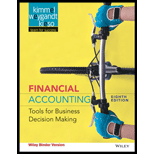
Concept explainers
(a)
Cash: Cash is the money which is readily available in the form of currency. Since cash can be easily converted into other types of assets, it is reported as current assets in the assets section as the most liquid asset.
Forms of cash:
- Coins
- Currency or paper money
- Checks
- Money orders
- Traveler’s checks
- Funds in checking accounts
- Funds in savings account
The following items are not considered as cash because they are near-cash items but not cash:
- Certificates of deposit
- Postdated checks
- Non-sufficient fund checks
- IOUs (‘I owe you’)
Cash and cash equivalents: Cash equivalents are the near-cash items, which are readily convertible into cash. Cash equivalents have a maturity period of three months, or less than 3 months. Cash equivalents are reported along with cash in the assets section of the
To determine: The balance of ‘Cash and cash equivalents’ to be reported on the balance sheet of Incorporation W, as at April 30, 2017.
(b)
To indicate: The accounts and statements where the items which are not included as ‘Cash and Cash equivalents’ in part (a) should be reported
Want to see the full answer?
Check out a sample textbook solution
Chapter 7 Solutions
Financial Accounting 8th Edition
- Please give me true answer this financial accounting questionarrow_forwardHello tutor please given General accounting question answer do fast and properly explain all answerarrow_forwardMonroe Enterprises had beginning total liabilities of $65,000 and ending total liabilities of $85,000. The beginning balance in stockholders' equity was $75,000. During the year, total assets increased by $50,000. In addition, capital stock of $20,000 was issued, and dividends of $10,000 were declared and paid. How much was Monroe’s net income for the year?arrow_forward
- Wayne Manufacturing estimates that overhead costs for the next year will be $4,200,000 for indirect labor and $540,000 for factory utilities. The company uses machine hours as its overhead allocation base. If 180,000 machine hours are planned for the next year, what is the company's plantwide overhead rate?arrow_forwardI need assistance with this financial accounting question using appropriate principles.arrow_forwardPlease show me how to solve this financial accounting problem using valid calculation techniques.arrow_forward
 Financial AccountingAccountingISBN:9781305088436Author:Carl Warren, Jim Reeve, Jonathan DuchacPublisher:Cengage Learning
Financial AccountingAccountingISBN:9781305088436Author:Carl Warren, Jim Reeve, Jonathan DuchacPublisher:Cengage Learning
